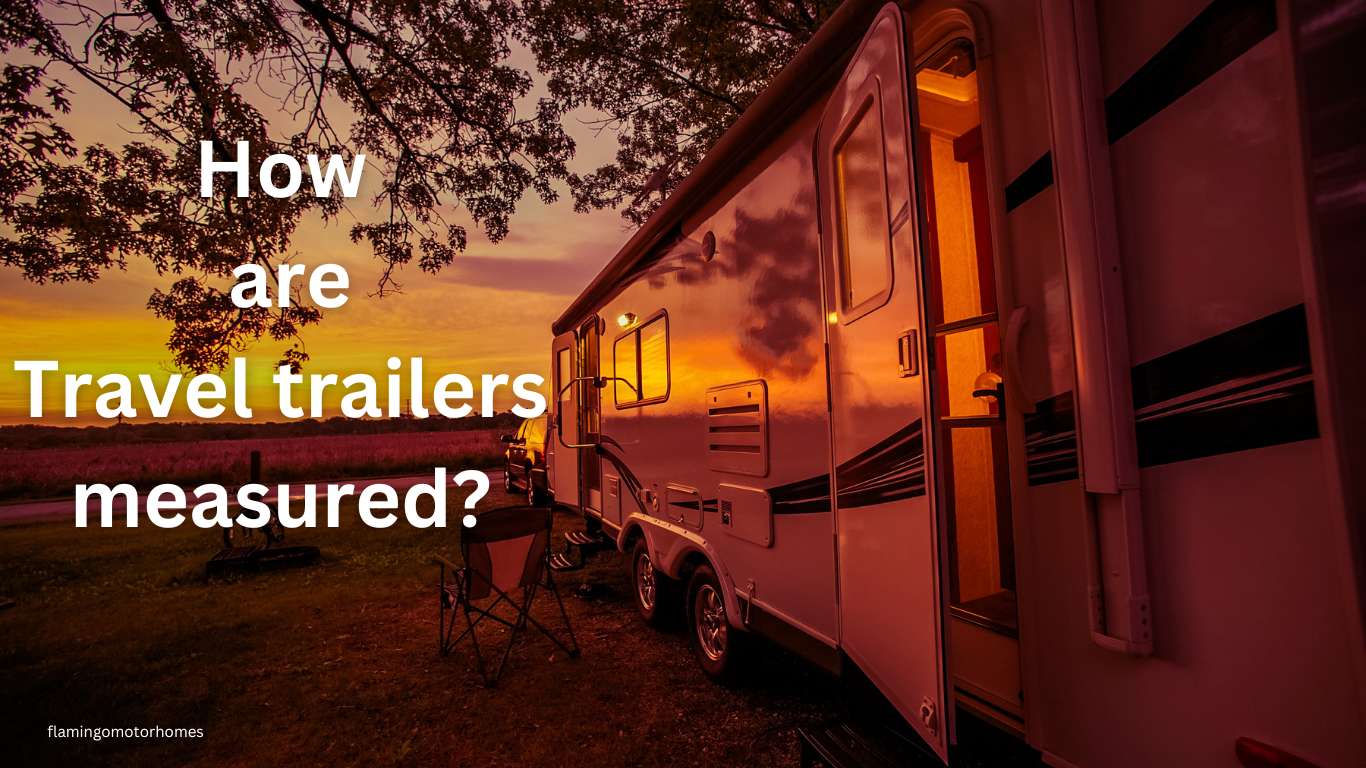Travel trailers are measured to help buyers determine the size, space, and functionality they offer. Accurate measurements ensure that the trailer fits your needs, your towing vehicle’s capacity, and any storage space requirements. Let’s dive into how travel trailers are measured and what you need to know. Measuring a travel trailer is an essential task that ensures safe towing, proper storage, and compatibility with campsites and regulations. Knowing the accurate dimensions of your travel trailer can help you avoid costly mistakes, plan better trips, and enjoy a stress-free travel experience. Let’s explore why this step is so important for every RV enthusiast.
Understanding Travel Trailer Length Measurement
The length of a travel trailer is the most commonly discussed measurement. Travel trailers are typically measured from the hitch to the rear bumper. This total length includes:
- The body of the trailer
- The A-frame or tongue
- Any rear bumpers or accessories
While some manufacturers focus on the living space length (excluding the hitch), the standard practice is to include the hitch to provide an overall dimension.
Measuring the Width of a Travel Trailer
The width of a travel trailer usually refers to the interior living space. Most travel trailers have a width between 8 to 8.5 feet, but this doesn’t account for slide-outs. When slide-outs are extended, the width can increase significantly, providing more room.
To measure the width:
- Measure from one exterior wall to the opposite exterior wall.
- Include additional space for extended features, if applicable.

Why Do We Need to Measure a Travel Trailer?
Measuring a travel trailer is a critical step for owners, buyers, and travelers alike. Accurate dimensions help ensure proper towing, safe storage, and compatibility with campsites and regulations. Let’s explore why measuring a travel trailer is so essential.

Ensuring Safe Towing
The length, width, and weight of a travel trailer directly impact towing safety. Knowing the dimensions helps in:
- Choosing the right towing vehicle: Larger trailers require vehicles with higher towing capacities.
- Avoiding accidents: Understanding the trailer’s size ensures safe driving on narrow roads and during turns.
- Weight distribution planning: Properly balanced weight prevents swaying and improves control.
Selecting the Right Storage Space
Accurate trailer measurements are essential for finding suitable storage:
- Garage storage: Trailers must fit within your garage or designated area without causing damage.
- RV storage facilities: Many facilities have size restrictions, so knowing your trailer’s dimensions ensures compatibility.
Navigating Campsites and RV Parks
Campsites and RV parks often have size limitations for parking spots:
- Length restrictions: Some campsites accommodate trailers up to a specific length only.
- Slide-out width: Measuring slide-out extensions ensures enough clearance in tight camping spots.
- Height clearance: Knowing your trailer’s height prevents damage from low-hanging branches or structures.
Meeting Road Regulations
Road safety laws and regulations often dictate size limits for vehicles and trailers:
- Length and width: Ensure your trailer complies with state or country-specific road regulations.
- Height: Prevent issues with bridges, tunnels, or overpasses by knowing your trailer’s height.
Planning Renovations or Upgrades
If you’re planning to customize your travel trailer, accurate measurements are vital for:
- Installing features like awnings or solar panels.
- Adding storage solutions or interior modifications.
Enhancing Travel Convenience
Knowing your trailer’s size improves your overall travel experience:
- Pre-trip planning: Easily map out routes that accommodate your trailer’s dimensions.
- Stress-free travel: Avoid surprises on the road by understanding height and width limitations.
Tools or Equipment Needed to Measure a Travel Trailer
Accurately measuring a travel trailer requires the right tools and a systematic approach. Whether you’re a potential buyer, a current owner, or simply curious, having the correct equipment ensures precise results. Here’s a breakdown of the tools and how to use them effectively.

Essential Tools for Measuring a Travel Trailer
To measure a travel trailer, you’ll need tools that can handle various dimensions like length, width, and height. The most commonly used tools are:
- Measuring Tape
- A durable, retractable tape measure (at least 25-50 feet) is essential for measuring length and width.
- Opt for a tape measure with easy-to-read markings for accuracy.
- Laser Distance Measurer
- This modern tool simplifies measuring long distances, such as the trailer’s total length or height.
- It’s particularly useful for solo measurements or irregular spaces.
- Level
- Ensuring the trailer is on level ground is crucial for accurate measurements. A bubble or digital level helps verify the trailer’s position.
- Step Ladder
- A sturdy step ladder allows you to safely measure the height of the travel trailer, including roof-mounted components like air conditioners or vents.
- Notebook or Digital App
- Keep a notebook or use a measurement app to record all dimensions for future reference.
How to Measure Travel Trailer Length
- Use a measuring tape or laser measurer to measure from the front of the hitch to the rear bumper.
- Ensure the tape remains straight for the most accurate results.
- Note any additional features, such as bike racks, that extend the trailer’s length.
Tools for Measuring Travel Trailer Width
- A measuring tape or laser distance measurer works best for width.
- Measure from one exterior wall to the other, including slide-outs if applicable.
Measuring Travel Trailer Height Safely
- Use a step ladder to reach the trailer’s highest point.
- Place the measuring tape or laser tool at ground level, ensuring it aligns vertically with the roof’s highest feature.
- Include accessories like antennas or air conditioning units in the total height.
Additional Tips for Accurate Measurements
- Park the trailer on a flat, even surface.
- Ensure all slide-outs or extensions are fully deployed for maximum width.
- Double-check measurements for reliability.
How to Measure the Height of a Travel Trailer
Height measurement is crucial for clearance when towing or parking. Travel trailer height is measured from the ground to the highest point, often the air conditioning unit or roof vent.

Steps to Measure Any Travel Trailer
Measuring a travel trailer is a straightforward process when done systematically. By following these steps, you can ensure precise dimensions for towing, storage, or purchasing considerations.
Step 1 – Gather Necessary Tools
Before you begin, make sure you have the following tools:
- A long measuring tape (25–50 feet)
- A laser distance measurer (optional but helpful)
- A bubble or digital level
- A sturdy step ladder
- A notebook or smartphone to record measurements
Step 2 – Park on Level Ground
- Position the travel trailer on a flat, even surface.
- Use a level to confirm that the trailer is not tilted. Accurate measurements depend on a level setup.
Length
- Start from the front of the hitch or A-frame (the part that attaches to the towing vehicle).
- Extend the measuring tape along the trailer to the rear bumper.
- If the trailer has additional features like a spare tire or bike rack, include these in the total length.
the Width
- Measure the width from one exterior wall to the opposite exterior wall.
- If the trailer has slide-outs, extend them fully and include the additional space.
- Note both the width with slide-outs retracted and extended for accurate data.
Height
- Use a step ladder to safely reach the highest point of the trailer.
- Measure from the ground to the roofline, ensuring the measuring tape or laser tool stays vertical.
- Include roof-mounted features like air conditioners, antennas, or vents in your measurement.
Double-Check Measurements
- Re-measure each dimension to ensure accuracy.
- Record the length, width, and height clearly for future reference.
Why Accurate Travel Trailer Measurements Matter
Understanding the exact size of your travel trailer ensures:
- Safe towing with an appropriately sized vehicle.
- Compatibility with storage facilities or campsites.
- Compliance with road clearance and parking regulations.
Common Mistakes While Measuring a Travel Trailer and Their Solutions
Measuring a travel trailer might seem simple, but common mistakes can lead to inaccurate results. These errors could affect towing safety, storage planning, and even campsite compatibility. Here’s a list of frequent mistakes and how to avoid them for precise measurements.

Mistake 1 – Measuring on Uneven Ground
Problem:
Uneven ground can skew the height, length, or width measurements, leading to inaccurate dimensions.
Solution:
- Always park the travel trailer on a flat, level surface before measuring.
- Use a bubble or digital level to confirm that the trailer is stable and even.
Mistake 2 – Excluding the Hitch or Bumper
Problem:
Many people only measure the trailer body and forget to include the hitch, tongue, or rear bumpers, which are critical parts of the total length.
Solution:
- Start measuring from the front tip of the hitch to the rear edge of the bumper.
- Always clarify whether you’re noting the overall length or just the living space length.
Mistake 3 – Ignoring Slide-Out Extensions
Problem:
Measuring the trailer without extending slide-outs underestimates the actual width. This can cause issues at campsites or storage areas.
Solution:
- Fully extend all slide-outs before measuring the width.
- Record both measurements: the width with slide-outs retracted and fully extended.
Mistake 4 – Forgetting Roof-Mounted Accessories
Problem:
Failing to include roof-mounted items like air conditioning units, antennas, or vents can result in incorrect height measurements, risking clearance issues during travel.
Solution:
- Measure the height from the ground to the tallest point, including all roof accessories.
- Use a step ladder and a measuring tape or laser tool for accuracy.
Mistake 5 – Using Incorrect Tools
Problem:
Using a short measuring tape or unreliable tools can make measurements inaccurate or inconsistent.
Solution:
- Use a long measuring tape (25–50 feet) or a laser distance measurer for greater precision.
- Double-check measurements with reliable tools.
Mistake 6 – Not Recording Measurements Properly
Problem:
Failing to note measurements immediately can lead to confusion or loss of critical data.
Solution:
- Record dimensions in a notebook or a digital app immediately after measuring.
- Label each measurement clearly (e.g., “total length,” “width with slide-outs”).
Mistake 7 – Measuring in Poor Lighting Conditions
Problem:
Low visibility can lead to errors, especially when using a measuring tape.
Solution:
- Measure in bright daylight or use portable lights if necessary.
- Ensure all tools are clearly visible for accurate readings.
Why Avoiding These Mistakes Matters
Accurate measurements are essential for:
- Ensuring safe towing and clearance.
- Selecting compatible storage spaces or campsites.
- Avoiding unnecessary repairs caused by misjudged dimensions.
More related information will be available on Flamingo Motorhomes.

